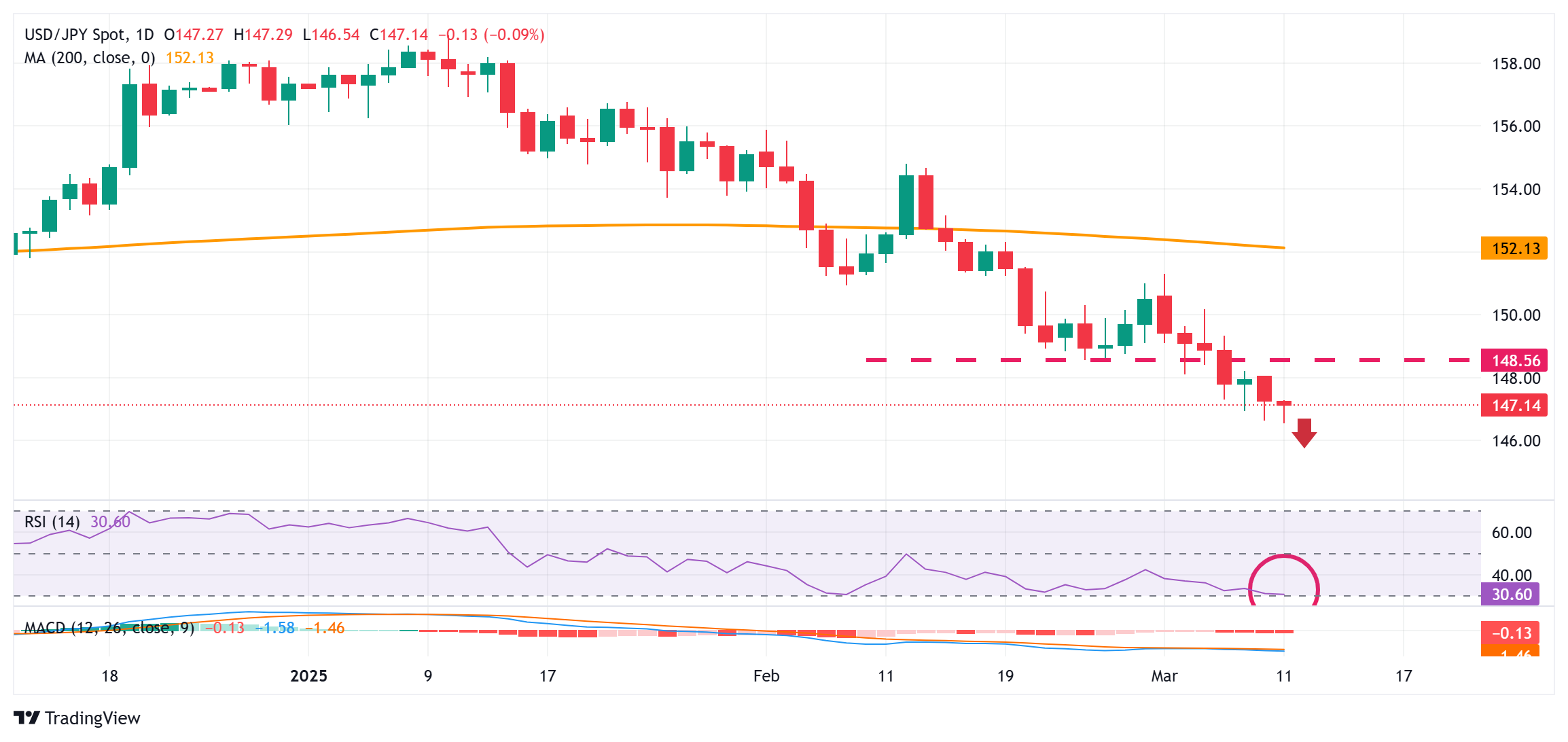- The Japanese Yen attracts safe-haven flows amid trade war fears and risk-off mood.
- A downward revision of Japan’s Q4 GDP does little to dent the JPY bullish sentiment.
- The divergent BoJ-Fed expectations support prospects for a further USD/JPY decline.
The Japanese Yen (JPY) retains positive bias and is currently placed near the highest level since early October touched against its American counterpart during the Asian session on Tuesday. Despite the downward revision of Japan’s Q4 GDP print, investors seem convinced that the Bank of Japan (BoJ) will hike interest rates further amid broadening inflation in Japan. This, along with the recent sharp narrowing of the yield differential between Japan and other countries, underpins the lower-yielding JPY.
Meanwhile, worries about the potential economic fallout from US President Donald Trump’s trade tariffs continue to weigh on investors’ sentiment. This is evident from a generally weaker tone around the equity markets, which turns out to be another factor that benefits the JPY’s relative safe-haven status. Apart from this, the prevalent US Dollar (USD) selling bias, fueled by bets that the Federal Reserve (Fed) will cut rates multiple times this year, exerts downward pressure on the USD/JPY pair.
Japanese Yen bulls retain control amid hawkish BoJ expectations and risk-off mood
- The Cabinet Office’s revised data released this Tuesday showed that Japan’s economic growth slowed to 2.2% on an annualized basis in the fourth quarter, lower than the initial estimate of 2.8% rise. On a quarter-to-quarter basis, the economy expanded by 0.6% as compared with a 0.7% growth in preliminary data released last month.
- The data reaffirms market bets that the Bank of Japan will keep the policy rate steady at its next policy meeting on March 18-19. That said, traders are pricing in the possibility of another BoJ rate hike as soon as May amid concerns about broadening inflation in Japan and hopes that bumper wage hikes seen last year will continue this year.
- BoJ Deputy Governor Shinichi Uchida signaled last week that the central bank was likely to raise interest rates at a pace in line with dominant views among financial markets and economists. This had been a key factor behind the recent surge in the 10-year Japanese government bond yield to its highest level since October 2008 set on Monday.
- Japan’s Economy Minister Ryosei Akazawa highlighted the importance of exchange rates moving in accordance with economic fundamentals while reaffirming that monetary policy decisions rest with the BoJ. Separately, Japan’s Finance Minister Shunichi Kato said that higher long-term interest rates could have wide-ranging effects on the economy.
- Meanwhile, Japan Trade Minister Yoji Muto said that he would continue discussing tariffs with the US and did not confirm that Japan is exempt from steel tariffs. US President Donald Trump’s 25% tariffs on global steel and aluminum imports go into effect on Wednesday. Furthermore, there are other levies planned for April 2.
- The US Dollar languishes near its lowest level since November amid the growing acceptance that the Federal Reserve will start its rate-cutting cycle sooner amid signs of a weakening US labor market. This, along with the uncertainty over Trump’s trade policies and their impact on the US economic growth, backs the case for further monetary easing.
- Traders now look forward to the Job Openings and Labor Turnover Survey (JOLTS) for some impetus later during the North American session. The focus, however, will remain glued to the latest US consumer inflation figures on Wednesday, which will influence the USD price dynamics and determine the near-term trajectory for the USD/JPY pair.
USD/JPY seems vulnerable to slide further while below 148.70-148.60 support breakpoint

From a technical perspective, the Relative Strength Index (RSI) on the daily chart remains on the verge of breaking into the oversold territory and warrants some caution for bearish traders. Hence, it will be prudent to wait for some near-term consolidation or a modest bounce before positioning for an extension of a two-month-old downtrend. However, any attempted recovery beyond the 147.25-147.30 immediate hurdle is likely to attract fresh sellers ahead of the 148.00 round figure. This is followed by the 148.60-148.70 strong horizontal support breakpoint, now turned resistance, which should now act as a key pivotal point and cap the USD/JPY pair.
On the flip side, the Asian session swing low, around the 146.55-146.50 area, could offer some support, below which the USD/JPY pair could accelerate the slide towards the 146.00 mark. The downward trajectory could extend further towards the 145.25 intermediate support en route to the 145.00 psychological mark.
Japanese Yen FAQs
The Japanese Yen (JPY) is one of the world’s most traded currencies. Its value is broadly determined by the performance of the Japanese economy, but more specifically by the Bank of Japan’s policy, the differential between Japanese and US bond yields, or risk sentiment among traders, among other factors.
One of the Bank of Japan’s mandates is currency control, so its moves are key for the Yen. The BoJ has directly intervened in currency markets sometimes, generally to lower the value of the Yen, although it refrains from doing it often due to political concerns of its main trading partners. The BoJ ultra-loose monetary policy between 2013 and 2024 caused the Yen to depreciate against its main currency peers due to an increasing policy divergence between the Bank of Japan and other main central banks. More recently, the gradually unwinding of this ultra-loose policy has given some support to the Yen.
Over the last decade, the BoJ’s stance of sticking to ultra-loose monetary policy has led to a widening policy divergence with other central banks, particularly with the US Federal Reserve. This supported a widening of the differential between the 10-year US and Japanese bonds, which favored the US Dollar against the Japanese Yen. The BoJ decision in 2024 to gradually abandon the ultra-loose policy, coupled with interest-rate cuts in other major central banks, is narrowing this differential.
The Japanese Yen is often seen as a safe-haven investment. This means that in times of market stress, investors are more likely to put their money in the Japanese currency due to its supposed reliability and stability. Turbulent times are likely to strengthen the Yen’s value against other currencies seen as more risky to invest in.
Information on these pages contains forward-looking statements that involve risks and uncertainties. Markets and instruments profiled on this page are for informational purposes only and should not in any way come across as a recommendation to buy or sell in these assets. You should do your own thorough research before making any investment decisions. FXStreet does not in any way guarantee that this information is free from mistakes, errors, or material misstatements. It also does not guarantee that this information is of a timely nature. Investing in Open Markets involves a great deal of risk, including the loss of all or a portion of your investment, as well as emotional distress. All risks, losses and costs associated with investing, including total loss of principal, are your responsibility. The views and opinions expressed in this article are those of the authors and do not necessarily reflect the official policy or position of FXStreet nor its advertisers. The author will not be held responsible for information that is found at the end of links posted on this page.
If not otherwise explicitly mentioned in the body of the article, at the time of writing, the author has no position in any stock mentioned in this article and no business relationship with any company mentioned. The author has not received compensation for writing this article, other than from FXStreet.
FXStreet and the author do not provide personalized recommendations. The author makes no representations as to the accuracy, completeness, or suitability of this information. FXStreet and the author will not be liable for any errors, omissions or any losses, injuries or damages arising from this information and its display or use. Errors and omissions excepted.
The author and FXStreet are not registered investment advisors and nothing in this article is intended to be investment advice.


![A sea of red for US equities [Video]](https://www.newsh2o.com/wp-content/uploads/2025/03/1893-a-sea-of-red-for-us-equities-video.png)
